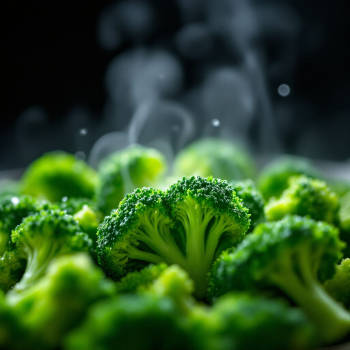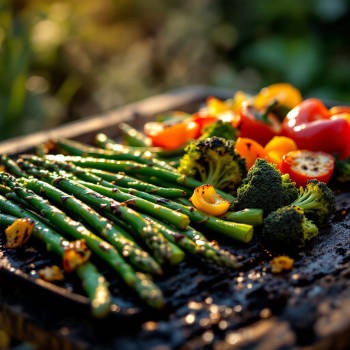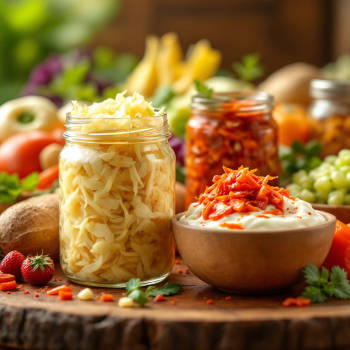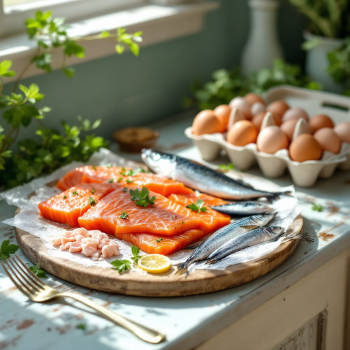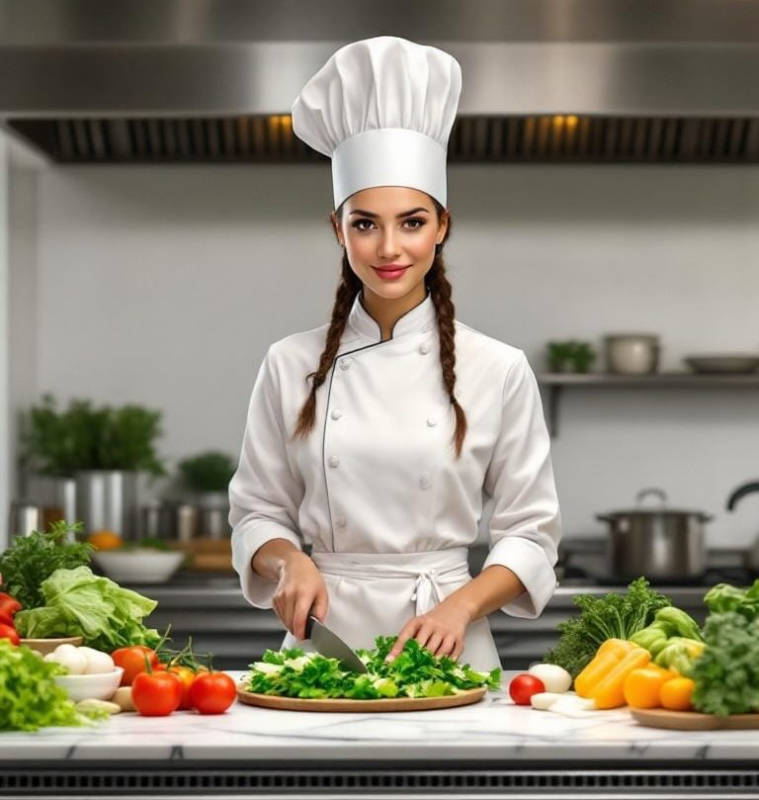
Healthy Prep Tips and Ingredients
Based on the latest nutrition science, here are some general health recommendations for cooking and food.
1. Optimal Cooking Methods For Nutrient Retention
• Steaming ⭐⭐⭐⭐⭐
Best for: All vegetables, especially broccoli, cauliflower, leafy greens
Benefits: Retains 85-91% of vitamin C, preserves water-soluble vitamins
Technique: Use minimal water, tight-fitting lid, 3-6 minutes maximum
Health Impact: Highest nutrient retention of all cooking methods
• Poaching ⭐⭐⭐⭐⭐
Best for: Delicate proteins (fish, chicken, eggs), fruits
Benefits: Gentle heat preserves protein structure, no added fats needed
Technique: Submerge in simmering (not boiling) liquid, 160-180°F
Health Impact: Maintains protein bioavailability, anti-inflammatory
• Griddling/Dry Sautéing ⭐⭐⭐⭐
Best for: Asparagus, green beans, broccoli, peppers
Benefits: Minimal oil use, intense flavors, quick cooking
Technique: High heat, minimal healthy oil (extra virgin olive oil)
Health Impact: Preserves antioxidants, enhances phytonutrient absorption
• Roasting (Low-Medium Heat) ⭐⭐⭐⭐
Best for: Root vegetables, tomatoes, proteins
Benefits: Concentrates flavors, maintains most nutrients
Technique: 300-375°F, minimal oil, whole vegetables when possible
Health Impact: Increases lycopene in tomatoes, maintains mineral content
2. Health-Negative Cooking Methods (Avoid/Minimize)
• Deep Frying ❌
Problems: Creates harmful compounds (AGEs), destroys nutrients, adds inflammatory oils
Health Impact: Promotes inflammation, oxidative stress
• High-Heat Grilling (Over 375°F)⚠️
Problems: Creates potentially carcinogenic compounds, destroys B vitamins
Health Impact: May form harmful chemical compounds
• Prolonged Boiling ⚠️
Problems: Leaches water-soluble vitamins into cooking water
Alternative: If boiling, consume the cooking liquid in soups/stews
3. Health-Positive Ingredients To Add
• Microgreens (Ultra Health-Positive) ⭐⭐⭐⭐⭐
Varieties: Broccoli, kale, arugula, radish, pea shoots, sunflower
Benefits: 4-40x more nutrients than mature vegetables, concentrated antioxidants
Preparation: Raw only, wash gently, add as finishing garnish
Health Expert Status: Strongly recommended by nutrition researchers
• Sea Vegetables (Health-Positive) ⭐⭐⭐⭐
Varieties: Kombu, nori, wakame, dulse
Benefits: High iodine for thyroid function, immune-boosting fucoidan, minerals
Preparation: Soak dried varieties, add to soups, use as seasoning
Health Expert Status: Traditional superfood with modern validation
• Fermented Foods (Health-Positive) ⭐⭐⭐⭐⭐
Varieties: Sauerkraut, kimchi, kefir, organic yogurt (no sugar), fermented vegetables
Benefits: Probiotics for gut health, enhanced nutrient absorption, immune support
Preparation: Consume raw/unpasteurized when possible
Health Expert Status: Universally recommended by health practitioners
• Nutrient-Dense Proteins (Health-Positive)
Wild-caught fish ⭐⭐⭐⭐⭐: Salmon, sardines, anchovies (omega-3 rich)
Grass-fed meats ⭐⭐⭐⭐: Higher omega-3, CLA, better amino acid profile
Pasture-raised eggs ⭐⭐⭐⭐: Complete protein, choline, vitamin D
Organic poultry ⭐⭐⭐⭐: Clean protein source
• Healthy Fats (Health-Positive)
Extra virgin olive oil ⭐⭐⭐⭐⭐: Cold-pressed, for low-heat cooking
Avocados ⭐⭐⭐⭐⭐: Monounsaturated fats, fiber, minerals
Coconut oil ⭐⭐⭐⭐: Stable for higher heat cooking
Nuts and seeds ⭐⭐⭐⭐: Almonds, walnuts, chia seeds, hemp seeds
4. Health Expert Recommendations Synthesis
• Dr. Eric Berg's Priorities:
✅ Health-Positive:
Cruciferous vegetables (broccoli, kale, arugula)
Healthy fats (coconut oil, avocado)
Quality proteins (grass-fed beef, wild fish)
Fermented foods (sauerkraut)
❌ Health-Negative:
Processed foods and vegetable oils
High-carb plant proteins (beans, grains in excess)
Sugar and refined carbohydrates
• Dr. Joseph Mercola's Approach:
✅ Health-Positive:
Organic vegetables (especially leafy greens)
Fermented foods for gut health
Healthy fats and quality proteins
Anti-inflammatory foods
❌ Health-Negative:
Processed foods and artificial ingredients
Conventional produce with pesticide residues
Trans fats and industrial oils
5. Ingredient Categorization System
• Tier 1: Superfoods (Daily consumption recommended)
Leafy greens (kale, spinach, arugula)
Microgreens (all varieties)
Cruciferous vegetables (broccoli, cauliflower, Brussels sprouts)
Fermented vegetables
Wild-caught fatty fish
Avocados
Extra virgin olive oil
• Tier 2: Health-Positive(Regular consumption beneficial)
Colorful vegetables (peppers, carrots, beets)
Sea vegetables
Grass-fed meats
Nuts and seeds
Herbs and spices (turmeric, ginger, garlic)
Organic berries
• Tier 3: Neutral (Moderate consumption acceptable)
Organic whole grains (for carb-tolerant individuals)
Legumes (properly prepared)
Conventional organic produce
• Tier 4: Health-Negative (Minimize or avoid)
Processed meats
Refined sugars and flours
Industrial seed oils (canola, soybean, corn oil)
Heavily processed foods
Artificial additives and preservatives
6. Sophisticated Healthy Recipes
• Mode 1: Steamed Nutrient-Dense Bowl
Base: Steamed broccoli, cauliflower, Brussels sprouts (5-6 minutes)
Protein: Poached wild salmon or pastured eggs
Fats: Drizzle extra virgin olive oil, avocado slices
Finish: Microgreens, sea salt, lemon juice
Health Rating: ⭐⭐⭐⭐⭐
• Mode 2: Fermented Power Salad
Base: Raw arugula, kale (massaged with salt)
Fermented: Sauerkraut, kimchi
Protein: Grass-fed beef strips (lightly griddled)
Fats: Olive oil vinaigrette, pumpkin seeds
Finish: Microgreens, herbs
Health Rating: ⭐⭐⭐⭐⭐
• Mode 3: Sea Vegetable Soup
Base: Kombu dashi broth
Vegetables: Lightly steamed bok choy, shiitake mushrooms
Protein: Miso-marinated fish (poached)
Extras: Wakame, green onions
Health Rating: ⭐⭐⭐⭐⭐
• Mode 4: Anti-Inflammatory Curry
Base: Coconut milk, turmeric, ginger
Vegetables: Steamed cauliflower, carrots (roasted whole)
Protein: Pastured chicken (poached in broth)
Fats: Coconut oil for sautéing spices
Health Rating: ⭐⭐⭐⭐
• Mode 5: Microgreen Power Bowl
Base: Variety of microgreens (broccoli, pea, sunflower)
Vegetables: Lightly griddled asparagus, bell peppers
Protein: Soft-poached eggs
Fats: Avocado, olive oil drizzle
Health Rating: ⭐⭐⭐⭐⭐
• Mode 6: Gut-Health Focus
Base: Fermented vegetable medley
Vegetables: Steamed leafy greens
Protein: Bone broth (with collagen)
Fats: MCT oil or ghee
Probiotics: Kefir or yogurt (unsweetened)
Health Rating: ⭐⭐⭐⭐⭐
• Mode 7: Quick Nutrient Blast
Base: Microwaved vegetables (2-3 minutes)
Protein: Canned wild salmon or sardines
Fats: Olive oil, nuts
Finish: Sea vegetables (nori flakes), microgreens
Health Rating: ⭐⭐⭐⭐
7. Implementation Guidelines
• Daily Nutrition Targets:
Vegetables: 7-9 servings, emphasizing variety and color
Healthy Fats: 30-35% of calories from quality sources
Protein: 0.8-1.2g per kg body weight from quality sources
Fermented Foods: 1-2 servings daily
Microgreens: 1-2 oz daily as nutritional insurance
• Cooking Principles:
1. Minimize cooking time shorter = better nutrient retention
2. Use minimal water steam rather than boil
3. Cook whole when possible less surface area exposed to heat
4. Add fats for absorption enhances fat-soluble vitamin uptake
5. Don't overcook proteins preserves amino acid structure
• Quality Standards:
Prioritize organic for "dirty dozen" produce
Choose grass-fed/pastured animal products
Select wild-caught over farmed fish
Use cold-pressed, unrefined oils
Avoid foods with artificial additives
8. Health Tips Summary
• Why These Methods Work:
Steaming preserves heat-sensitive vitamins while making nutrients more bioavailable
Gentle cooking maintains enzyme activity and phytonutrient structures
Healthy fats improve absorption of fat-soluble vitamins (A, D, E, K)
Fermented foods pre-digest nutrients and support gut health
Microgreens provide concentrated nutrition in small portions
• Scientific Backing:
Studies show steaming retains 85-91% of vitamin C vs. 50% loss in boiling
Microgreens contain 4-40x more nutrients than mature vegetables
Fermented foods improve mineral absorption and support immune function
Sea vegetables provide unique compounds not found in land plants
9. Classical Cooking Terms
Chef Auguste Escoffier was highly influential and was central to the formulation and codification of classical French cuisine in the late 19thC, which became the basis of 20thC Western cuisine. Though classical cuisine was optimized for taste rather than health, here are a few key terms which may be referred to in ChefiChoice.
Roux; eight parts of butter and nine parts of white flour are stirred and gently heated together in a thick-bottomed pan to roast the flour lightly (for white roux), and gradually very lightly browning it for pale roux and a little more for a brown roux, to be used for the thickening of sauces.
Velouté; hot light stock is gradually stirred into a hot pale roux thickening it, to form a velouté, the base for light brown sauces.
Béchamel; similarly, hot milk is stirred slowly into a white roux then whisked to form béchamel, a white sauce base.
Mirepoix; a flavor base for stocks and sauces consisting chiefly of onion, celery, carrot, a bouquet garni—a removable bundle of parsley, thyme and a bay leaf, and sometimes ham or bacon. 🌶️



